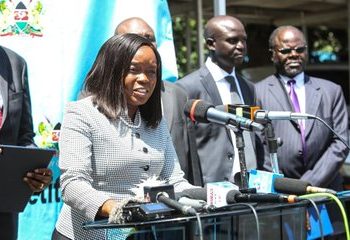By Mike Mwaniki
Kenya has one of the highest uptakes of people living with HIV who are on antiretroviral therapy treatment in the world. Out of the 1.5 million people living with HIV, 1,136,000 have been enrolled on the life-prolonging medicines.
Speaking to Health Business magazine, the National Aids and STI Control Programme (NASCOP) Head, Dr. Kigen Bartilol said HIV treatment in Kenya represents coverage of 75 per cent compared to the global average of 53 per cent.
“In addition to antiretroviral therapy, patients receive a mix of services including nutritional support, screening and treatment of other infections and conditions such as cancers and cardiovascular illness and Tuberculosis,” said Dr. Bartilol.
Dr. Bartilol announced that NASCOP plans to roll-out newer and more effective ARVs known as DTG in June which has a higher viral suppression compared to the existing drugs in the market.
“Although the National HIV prevalence rate has now declined to the current 5.6 per cent from the previous high of 14 per cent in the 1990s, Kenya still experiences about 71,000 new HIV infections annually. A majority of the new infections, 41 per cent are occurring among adolescents aged between 15 to 25 years,” revealed the medic.
Dr. Bartilol appealed to all those who have not undergone HIV testing to do so saying the HIV testing is the main entry to accessing prevention, care and treatment interventions. “We are now recommending life- saving antiretroviral treatment for all people living with HIV in a programme we have dubbed ‘Anza Sasa’.
These will enable those who are infected to access newer, safer, efficacious and well tolerated ARVS formulations that will achieve viral suppression in a much shorter time,” he explained.
Dr .Bartilol noted that since voluntary male medical circumcision (VMMC) was introduced in 2008 among non-circumcising communities, 1.4 million men have undergone this procedure which reduces female to male HIV infection by 60 per cent.
“The number of those who have been circumcised presents coverage of 91 per cent against our targets. Annually, over 260,000 circumcisions are done in Kenya mainly targeting areas where men are traditionally not circumcised,” Dr. Bartilol stated. The NASCOP boss noted that the Prevention of Mother to Child transmission of HIV (PMTCT) aims at eliminating the Mother to Child transmission of HIV and Congenital syphilis in Kenya by the year 2021.
“Prevention of mother to child transmission interventions have resulted in identification of 57,796 pregnant positive women and of these, 92 per cent (53,236), were enrolled on HIV treatment which is one of the main strategies for preventing transmissions,” he noted. Dr, Bartilol said mother to child transmission rate as per the 2015 Kenya HIV estimates is currently at 8.2 per cent from a high of 16 per cent in 2012.
The NASCOP head said in the last five years, the Ministry of Health has strengthened provision of services to populations considered to be at high risk of HIV commonly referred to as key populations. These include men having sex with men (MSM), female sex workers (FSW), and persons who inject drugs (PWID) among others who contribute 30 per cent of new HIV infections in Kenya.















